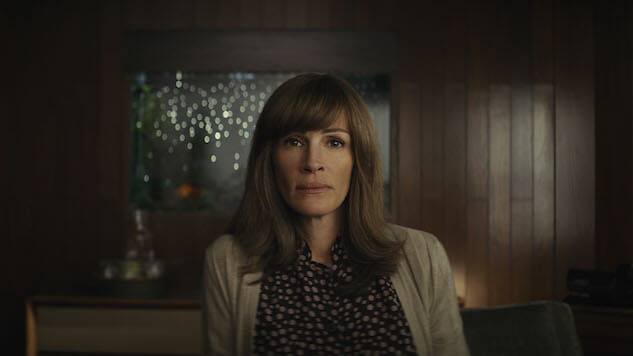How Homecoming‘s Julia Roberts Uses Her Star Persona to Craft One of the Year’s Best Performances
Photo: Amazon Prime Video
In the fifth episode of Amazon’s Homecoming, our protagonist—if not quite heroine—Heidi Bergman approaches a department store makeup counter. She appears assured, sun-kissed, in her yellow blazer and orange shirtdress, and also uncertain, her steps tentative, her glance wavering. Until, that is, she’s lured in by a shop clerk’s promise of plumper lips, sealed with a flattering question: “What’s your beauty regimen?” When she pulls up outside her office building in the next scene, it’s with that sudden bloom of rom-com confidence—the big eyes cast skyward; the full, pink lips; the satisfied sigh; the smile to herself in the rearview mirror. I already know this woman, at least by her aliases: Vivian Ward, Julianne Potter, perhaps a pre-fame Anna Scott. You do, too. She’s Julia Roberts.
As Heidi—the first recurring TV role of her 30-year career—Roberts isn’t simply playing the caseworker at Homecoming, an experimental facility for recently discharged soldiers. She is, after a fashion, playing all of the women she’s been before: In Homecoming’s dual timelines, one set during Heidi’s tenure at Homecoming and another, four years later, in which an investigator from the Department of Defense (Shea Whigham) pries into the mysterious goings-on there, one might catch glimpses of—even references to—her romantic comedies (Pretty Woman, My Best Friend’s Wedding), her early thrillers (Sleeping with the Enemy, The Pelican Brief), her darker side (Closer), her Oscar turn (Erin Brockovich). Layered this way, with softness in stretches and brassiness in others, harried to distraction or delivering that megawatt grin, the performance has the feeling of one of her forays into the self-referential, from the cameos as herself (The Player, Murphy Brown) to Steven Soderbergh’s Full Frontal, in which she plays a movie star slumming it in an unglamorous role. Indeed, it’s as if Roberts has drawn on her entire reservoir of experience to forge a new depth of craft: Homecoming is her strongest work since August: Osage County (2013), and one of the best performances of the year.
Her character is the center of the season’s intertwining mysteries, keeping Homecoming aloft when its chased-after conspiracies emerge as (mostly) dead weight. In essence, by coupling the questions swirling around Homecoming— managed from afar by the demanding, suspicious Colin Belfast (Bobby Cannavale)—with those swirling around Heidi—who appears, four years on, not to remember major aspects of her employment there—the series solves, or at least skirts, the puzzle-box problem. It’s not that the risk of detours, dead ends, red herrings, and other frustrating trademarks of director Sam Esmail’s much-diminished Mr. Robot is eliminated, exactly, but it’s lessened, or changed, by the enigma of Heidi herself.
In part, as Paste’s Jacob Oller writes in his review, this is credit to Roberts’ chemistry with Stephan James, who plays Walter Cruz, a veteran and Homecoming resident to whom Heidi takes a shine. Even more so, though, Heidi becomes Homecoming’s most unstable—and destabilizing—force, slipping the tethers of daily life, and thence of self. She is, by turns, an ingratiating counselor, a distracted girlfriend, a skittish waitress, a neglectful daughter; she might be a co-conspirator or a victim, the threat or the mark. As the series toggles between Homecoming, with its faint sci-fi complexion, and its long aftermath, reminiscent of David Fincher’s investigative noirs, Heidi appears to change her color with that of the light: At heart, she’s a shape-shifter, metamorph, mimic. “Don’t worry, I’m a liar, too,” she explains in a captivating exchange near the end of the sixth episode, “Toys,” written by former Paste TV editor Shannon M. Houston. “I’ll be in my car, or right when I wake up, and it’s like I just appeared out of nowhere. I can just see my whole life, phony, fake, and every word that I say, every second—if that’s the lie, where’s the other one, the real one?”